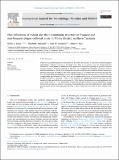| dc.contributor.author | Kessy, Stella | |
| dc.contributor.author | Makundi, RhodesH. | |
| dc.contributor.author | Massawe, Apia | |
| dc.contributor.author | Rija, Alfan | |
| dc.date.accessioned | 2024-04-29T12:11:15Z | |
| dc.date.available | 2024-04-29T12:11:15Z | |
| dc.date.issued | 2024-03-04 | |
| dc.identifier.issn | https://doi.org/10.1016/j.ijppaw.2024.100921 | |
| dc.identifier.uri | https://dspace.nm-aist.ac.tz/handle/20.500.12479/2533 | |
| dc.description | This research article was published by ELSEVIER,2024 | en_US |
| dc.description.abstract | Understanding rodent-ectoparasite interactions and the factors driving them is important in understanding the
epidemiology of diseases involving an arthropod vector. Fleas are the primary vector for Yersinia pestis, the
bacteria that causes plague and monitoring of flea population is essential for planning the potential mitigation
measures to prevent the disease outbreak. In this study, we investigated flea abundance, community structure
and the potential factors driving flea infestation in areas with frequent (persistent) and non-frequent plague (non-
persistent) outbreaks. We collected fleas from captured rodents in two villages with both forest and farm hab-
itats. We found 352 fleas belonging to 5 species with Dinopsyllus lypusus the most abundant overall (57.10%) and
Ctenophthalmus spp. the lowest (1.70%). There were no significant differences of flea abundance between study
localities, habitats and seasons (p > 0.05) but, flea infestation was significantly positively associated with the
persistent locality and with the short rain season (p < 0.05). Further, flea abundance increased significantly with
rodent body weight (p < 0.05). Furthermore, we found fleas broadly structured into two communities varying
between the dry, long rain and short rain seasons. These findings have important implications for public health,
as they may be used to assess and control the risks of plague transmission and other flea borne diseases in the
foci. | en_US |
| dc.language.iso | en | en_US |
| dc.publisher | ELSEVIER | en_US |
| dc.subject | Plague | en_US |
| dc.subject | Flea abundance | en_US |
| dc.subject | Flea community | en_US |
| dc.subject | Flea-rodent interactions | en_US |
| dc.title | International Journal for Parasitology: Parasites and Wildlife | en_US |
| dc.title.alternative | Flea infestation of rodent and their community structure in frequent and non-frequent plague outbreak areas in Mbulu district, northern Tanzania | en_US |
| dc.type | Article | en_US |

